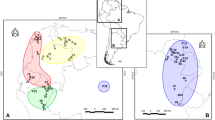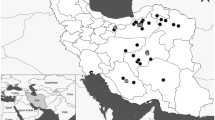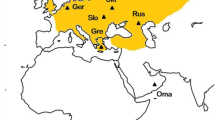Abstract
The phylogeographic pattern of mitochondrial DNA variation in capercaillie (Tetrao urogallus) from 14 populations across the European range was examined using sequence variation in the central portion of the control region and the cytochrome B gene. Twenty-nine different haplotypes were resolved, which formed two distinct phylogenetic clades. The major division separated haplotypes found in the Pyrenees from those found in the rest of Europe. However, two Pyrenean birds were found within the central European clade. The Pyrenean population is likely to be derived from an Iberian glacial refugium, whereas the other European populations have been recolonized from a refugium in the East. Birds from the Eastern refugium spread west until they reached the Pyrenees, where they mixed with birds from the Iberian refugium. Connectivity between populations from central, eastern, and northern Europe and the Pyrenees was interrupted by the extinction of interconnecting populations, leading to the formation of a different subspecies (Tetrao urogallus aquitanicus). We argue that the Pyrenean birds should be therefore regarded as a separate evolutionary significant unit, and we discuss the status of the other capercaillie populations in a conservation context.


Similar content being viewed by others
References
Akaike H (1974) A new look at the statistical model identification. IEEE Trans Autom Control 19:716–723
Castroviejo JB (1975) El urogallo en España. Monografías de la Estación Biológica de Doñana, Sevilla
Del Hoyo J, Elliott A, Sargatal J (eds) (1994) Handbook of the birds of the world, vol 2. Lynx Ediciones, Barcelona
Duriez O, Sachet JM, Ménoni E, Pidancier N, Miquel C, Taberlet P (2007) Phylogeography of the capercaillie in Eurasia: what is the conservation status in the Pyrenees and Cantabrian Mounts. Conser Genet 8(3):513
Hampe A, Petit RJ (2005) Conserving biodiversity under climate change: the rear edge matters. Ecol Lett 8:461–467
Hall TA (1999) BioEdit: a user friendly biological sequence alignment editor and analysis program for Windows 95/98/NT. Nucl Acids Symp Ser 41:95–98
Hewitt GM (2004) Genetic consequences of climatic changes in the Quaternaty. Phil Trans R Soc Lon B 359:183–195
Klaus S, Andreev AV, Bergmann H-H, Müller F, Porkert J, Wiesner J (1989) Die Auerhühner. Neue Brehm Bücherei. Ziemsen Verlag, Wittenberg
Kumar S, Tamura K, Nei M (2004) MEGA3: ingegrated software for molecular evolutionary genetics analysis and sequence alignment. Brief Bioinform 5:150–163
Liukkonen-Anttilla T, Rätti O, Kvist L, Helle P, Orell M (2004) Lack of genetic structuring and subspecies differentiation in the capercaillie (Tetrao urogallus) in Finnland. Ann Zool Fenn 41:619–633
Pakkala T, Pellikka J, Lindén H (2003) Capercaillie Tetrao urogallus—a good candidate for an umbrella species in taiga forests. Wildl Biol 9:309–316
Petit RJ, Aguinagalde I, de Beaulieu JL, Bittkau C, Brewer S, Cheddadi R, et al. (2003) Glacial refugia: hotspots but not melting pots of genetic diversity. Science 300:1563–1565
Posada D, Crandall KA (1998) Modeltest: testing the model of DNA substitution. Bioinformatics 14:817–818
Potapov RL, Flint VE (1989) Handbuch der Vögel der Sowjetunion. Band 4. Galliformes, Gruiformes. Ziemsen Verlag, Wittenberg
Rodriguez–Munoz R, Mirol PM, Segelbacher G, Fernández A, Tregenza T (2007) Genetic differentiation of an endangered capercaillie (Tetrao urogallus) population at the Southern edge of the species range. Conserv Genet 8(3):659–670
Rozas J, Sánchez-DelBarrio JC, Messeguer X, Rozas R (2003) DnaSP, DNA polymorphism analyses by the coalescent and other methods. Bioinformatics 19:2496–2497
Segelbacher G (2002) Non-invasive genetic analysis in birds: testing reliability. Mol Ecol Notes 2:367–369
Segelbacher G, Höglund J, Storch I (2003) From isolation to connectivity. Genetic consequences of population fragmentation in capercaillie across Europe. Mol Ecol 12:1773–1780
Storch I (2001) Capercaillie. BWP update. J Birds Western Palearctic 3:1–24
Suter W, Graf RF, Hess R (2002) Capercaillie (Tetrao urogallus) and avian biodiversity: testing the umbrella-species concept. Conserv Biol 16:778–788
Swofford D (1993) PAUP: phylogenetic analysis using parsimony. Illinois Natural History Survey, University of Illinois, Champaign, IL
Taberlet P, Fumagalli L, Wustsaucy AG, Cosson JF (1998) Comparative phylogeography and postglacial colonization routes in Europe. Mol Ecol 7:453–464
Acknowledgments
We are extremely grateful to all those individuals who helped collect feather samples for this study, especially Siegfried Klaus, Kenny Kortland, Emmanuel Menoni, Robert Moss, and Per Wegge. Skin samples from Poland (6289) and Romania (55986) were provided by the Swedish Museum of Natural History in Stockholm.
Author information
Authors and Affiliations
Corresponding author
Additional information
Communicated by F. Bairlein.
Rights and permissions
About this article
Cite this article
Segelbacher, G., Piertney, S. Phylogeography of the European capercaillie (Tetrao urogallus) and its implications for conservation. J Ornithol 148 (Suppl 2), 269–274 (2007). https://doi.org/10.1007/s10336-007-0153-1
Received:
Revised:
Accepted:
Published:
Issue Date:
DOI: https://doi.org/10.1007/s10336-007-0153-1




